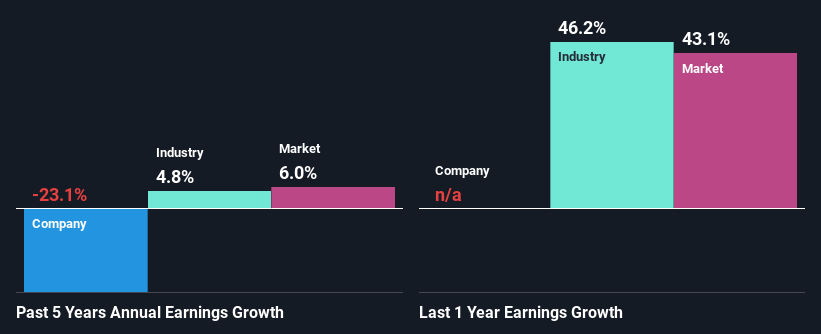Topps Tiles Plc's (LON:TPT) Fundamentals Look Pretty Strong: Could The Market Be Wrong About The Stock?
Topps Tiles (LON:TPT) has had a rough three months with its share price down 19%. But if you pay close attention, you might find that its key financial indicators look quite decent, which could mean that the stock could potentially rise in the long-term given how markets usually reward more resilient long-term fundamentals. Particularly, we will be paying attention to Topps Tiles' ROE today.
Return on Equity or ROE is a test of how effectively a company is growing its value and managing investors’ money. Simply put, it is used to assess the profitability of a company in relation to its equity capital.
View our latest analysis for Topps Tiles
How To Calculate Return On Equity?
The formula for return on equity is:
Return on Equity = Net Profit (from continuing operations) ÷ Shareholders' Equity
So, based on the above formula, the ROE for Topps Tiles is:
46% = UK£12m ÷ UK£26m (Based on the trailing twelve months to April 2022).
The 'return' is the yearly profit. Another way to think of that is that for every £1 worth of equity, the company was able to earn £0.46 in profit.
What Has ROE Got To Do With Earnings Growth?
Thus far, we have learned that ROE measures how efficiently a company is generating its profits. Depending on how much of these profits the company reinvests or "retains", and how effectively it does so, we are then able to assess a company’s earnings growth potential. Assuming everything else remains unchanged, the higher the ROE and profit retention, the higher the growth rate of a company compared to companies that don't necessarily bear these characteristics.
Topps Tiles' Earnings Growth And 46% ROE
Firstly, we acknowledge that Topps Tiles has a significantly high ROE. Second, a comparison with the average ROE reported by the industry of 18% also doesn't go unnoticed by us. As you might expect, the 23% net income decline reported by Topps Tiles doesn't bode well with us. So, there might be some other aspects that could explain this. These include low earnings retention or poor allocation of capital.
However, when we compared Topps Tiles' growth with the industry we found that while the company's earnings have been shrinking, the industry has seen an earnings growth of 4.8% in the same period. This is quite worrisome.
The basis for attaching value to a company is, to a great extent, tied to its earnings growth. It’s important for an investor to know whether the market has priced in the company's expected earnings growth (or decline). This then helps them determine if the stock is placed for a bright or bleak future. What is TPT worth today? The intrinsic value infographic in our free research report helps visualize whether TPT is currently mispriced by the market.
Is Topps Tiles Efficiently Re-investing Its Profits?
Topps Tiles has a high three-year median payout ratio of 66% (that is, it is retaining 34% of its profits). This suggests that the company is paying most of its profits as dividends to its shareholders. This goes some way in explaining why its earnings have been shrinking. The business is only left with a small pool of capital to reinvest - A vicious cycle that doesn't benefit the company in the long-run. To know the 3 risks we have identified for Topps Tiles visit our risks dashboard for free.
In addition, Topps Tiles has been paying dividends over a period of at least ten years suggesting that keeping up dividend payments is way more important to the management even if it comes at the cost of business growth. Our latest analyst data shows that the future payout ratio of the company over the next three years is expected to be approximately 61%.
Summary
In total, it does look like Topps Tiles has some positive aspects to its business. Yet, the low earnings growth is a bit concerning, especially given that the company has a high rate of return. Investors could have benefitted from the high ROE, had the company been reinvesting more of its earnings. As discussed earlier, the company is retaining a small portion of its profits. Until now, we have only just grazed the surface of the company's past performance by looking at the company's fundamentals. So it may be worth checking this free detailed graph of Topps Tiles' past earnings, as well as revenue and cash flows to get a deeper insight into the company's performance.
Have feedback on this article? Concerned about the content? Get in touch with us directly. Alternatively, email editorial-team (at) simplywallst.com.
This article by Simply Wall St is general in nature. We provide commentary based on historical data and analyst forecasts only using an unbiased methodology and our articles are not intended to be financial advice. It does not constitute a recommendation to buy or sell any stock, and does not take account of your objectives, or your financial situation. We aim to bring you long-term focused analysis driven by fundamental data. Note that our analysis may not factor in the latest price-sensitive company announcements or qualitative material. Simply Wall St has no position in any stocks mentioned.

 Yahoo Finance
Yahoo Finance 
